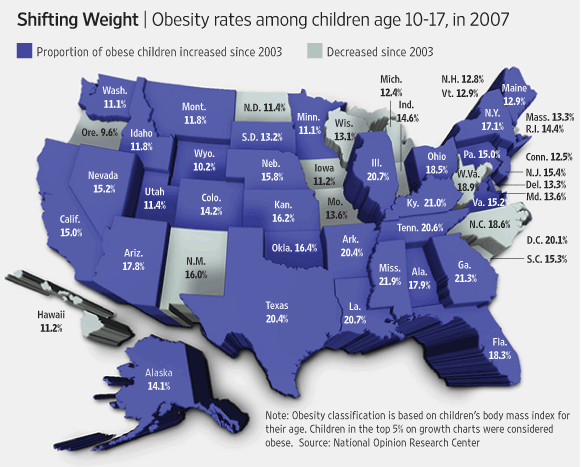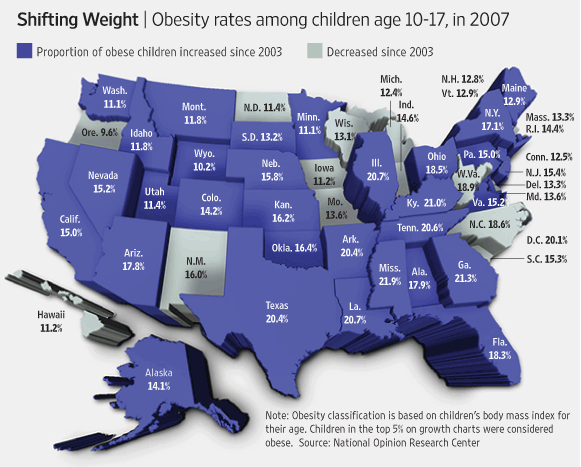Big people are big business in the United States, where about one in three adults and one in six children and adolescents are considered obese.
Diet programs, diet foods, zero-calorie drinks, exercise videos, fitness machines and gym memberships are some of the most advertised products in America. And that doesn’t include actual medical programs to treat obesity.
But as much awareness as there is of weight problems, Americans continue to get bigger.
It’s no secret that obesity takes a toll on health, often leading to chronic conditions like diabetes, hypertension and joint problems. What many don’t recognize is the financial burden — costs that go far beyond the individual.
In Georgia, nearly one in three adults is obese, and our childhood obesity rates are second only to Mississippi’s.
The health care costs linked to excess weight in Georgia’s adults are currently estimated at $2.5 billion per year, according to a 2009 report from United Health Foundation, the American Public Health Association and the Partnership for Prevention.
But if trends continue, the report projects these costs could reach $10.8 billion by 2018, when as many as 41 percent of Georgians could be obese.
“An obese adult spends about 40 percent more on health care than a normal-weight adult does in a given year,” said Kenneth Thorpe, lead researcher for the report and a professor of health policy and management at Emory University. “It adds expenditures, results in lower workplace productivity and a higher prevalence of chronic health conditions.”
While obese individuals pay more for their own health care, they aren’t the only ones who pay the price for their extra weight.
Businesses and taxpayers shoulder the burden as well. In Georgia, Medicare and Medicaid are estimated to pay 28 percent of the state’s obesity-attributable expenditures, according to a recent study published in the journal Obesity.
Why the big increase?
In the most basic terms, behavior is the main culprit in obesity, and Georgians rank among the lowest in the country in healthy lifestyles.
Only 17 percent of Georgia’s youths consume the recommended five servings of fruits and vegetables per day, according to the CDC. Fewer than half of Georgia adults and only one in four kids in 2009 got the recommended amount of physical activity –- two and a half hours of moderate activity per week.
But behavior has a lot to do with people’s surroundings and the situation they live in.
Unhealthy foods, such as those found at fast food restaurants, are often cheaper than nutritious meals — and in many places they’re more accessible.
The Georgia map is dotted with several USDA-designated “food deserts,’’ where nutritious foods such as fresh produce are not easy to buy. These pockets of poor nutrition are mostly in high-poverty inner-city Atlanta and rural areas in the southern half of the state. They also have high rates of obesity.
The most traditional form of exercise — walking — has become impractical in many areas because of urban sprawl. Many Georgians live far from where they work or go to school or shop, so they have to drive or ride instead of walking.
Every additional hour spent in a car translates to a 6 percent greater chance of being obese, according to a transportation study conducted by researchers at the Georgia Institute of Technology.
Who pays the price?
The most obvious costs of obesity are the diagnosis and treatment of chronic conditions that go with it.
“Managing chronic illness is an extremely expensive thing to do,” said Phaedra Corso, the department head for Health Policy and Management at the University of Georgia’s College of Public Health. “And we don’t have good systems of care to deal with chronic diseases.”
Someone who is overweight or obese could be seeing several doctors — one to manage diabetes, one to manage cardiovascular disease, one for joint issues — and taking numerous prescription drugs at the same time.
Add in lost wages due to disability or illness, and a lower quality of life, and obesity becomes a personal economic problem.
According to a George Washington University study, obese women employed full time earn 6 percent less than their healthier counterparts. With more treatment for obesity-related illness come larger bills and higher insurance premiums and higher costs for publicly funded programs like Medicaid and Medicare.
And it’s not just individuals who pay: Employees with additional pounds raise health care costs for everyone, including the businesses covering them. According to a 2010 Duke University study, obesity costs U.S. employers $73.1 billion annually in medical costs and lost productivity.
“There is an impact on the economic viability of the state, and on our ability to attract industry,” said Lizann Roberts, a health management consultant and executive board member for Healthy Savannah. “Ultimately this affects an employer’s bottom line.”
Prevention at work
Some Georgia businesses are addressing the problem directly.
Worksite prevention programs or employer referrals to wellness initiatives can improve worker productivity and therefore benefit employers.
“It’s about removing barriers to care,” said Gary Rost, executive director for the Savannah Business Group, a business coalition that buys health care services for local self-funded employers. “We encourage employers to pay for preventive care; paying for the small things first helps to avoid larger costs later.”
Members of the Savannah Business Group (SBG) have subsidized gym memberships, performed health risk assessments and changed the options available in cafeterias.
One member, the City of Savannah itself, has implemented a diabetes management program that includes weight loss as a goal. Rost said the city has noticed less absenteeism and fewer visits to the ER among its employees.
A healthier start
Addressing obesity before it happens is the best approach, but it requires foresight.
“Prevention is key for costs,” said UGA’s Corso. “But a lot of people don’t buy into the idea of prevention because we’re married to the cost effectiveness of treatment, where the time frame is shorter.”
The danger of childhood obesity, though, is becoming more obvious.
“We’re seeing so many diseases in kids that were traditionally only found in adults,” said Tim Whitehead, the vice president of marketing and communications for Children’s Healthcare of Atlanta, which is running a hard-hitting ad campaign about Georgia’s childhood obesity problem.
Diabetes, joint problems and heart disease are now showing up in obese children, not just adults. And kids with extra weight are 80 percent more likely than other children to become overweight adults, according to the CDC.
Annual health care costs for an obese child being treated for the condition are estimated at $2,500 to $4,200 more than for a normal-weight child, according to the Robert Wood Johnson Foundation.
The Georgia Department of Public Health has mounted a fight against obesity with programs to promote nutrition and encourage exercise.
State agencies and community groups are working with the nonprofit Georgia Organics to launch farm-to-school nutrition programs.
This year, Georgia schoolchildren will undergo a required fitness evaluation in physical education classes as part of SHAPE — the Student Health and Physical Education Act recently enacted by the General Assembly. Results will be sent to parents.
The state is even laying more sidewalks. This program, known as the Safe Routes to School Program, is funded by the Federal Highway Administration.
“We don’t want to penalize people for being obese, but provide them with the right avenues,” said Corso.
[youtube]http://www.youtube.com/watch?v=TNVROZoh8eE[/youtube]
Video by Marcie McClellan
This article is the latest in a series developed by the Public Health News Bureau, a project funded by Healthcare Georgia Foundation. The bureau is staffed by graduate students from the Health and Medical Journalism Graduate Program at the University of Georgia’s Grady College of Journalism and Mass Communication.
Laura Smith is a graduate student in Health & Medical Journalism at the University of Georgia. She is also a consulting writer and editor for the CDC.
Marcie McClellan is pursuing a master’s in Health & Medical Journalism and a certificate in Global Health at the University of Georgia. As a journalist, she covers child health and health disparities. She worked for three years developing prevention programs for youth in Fulton County.


